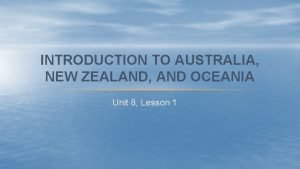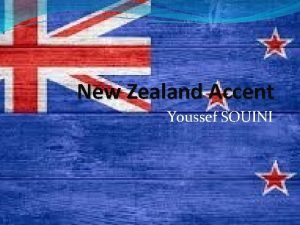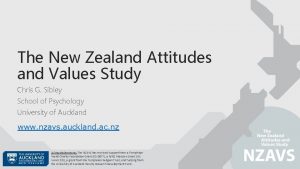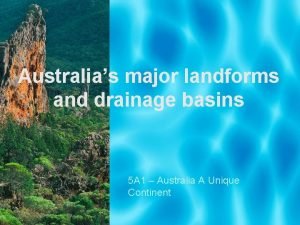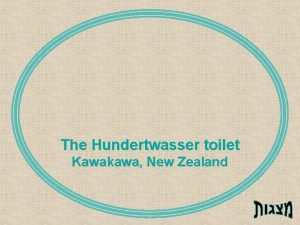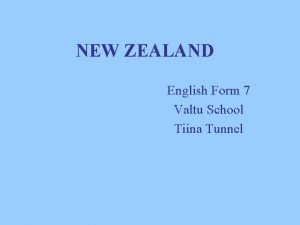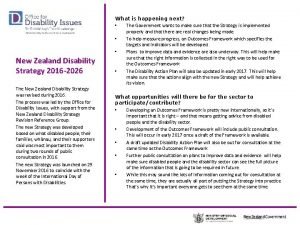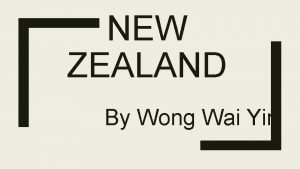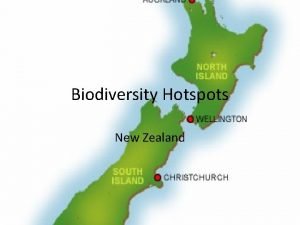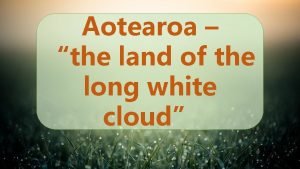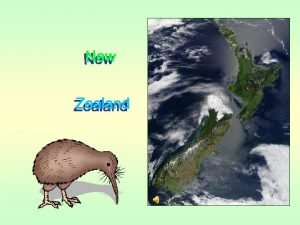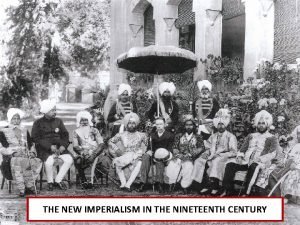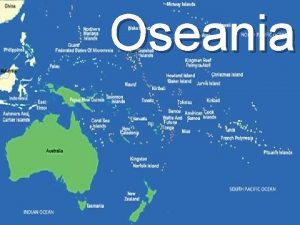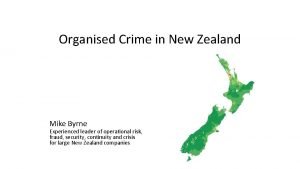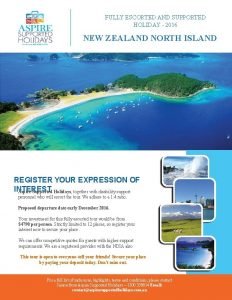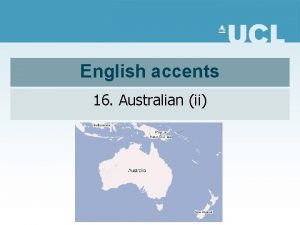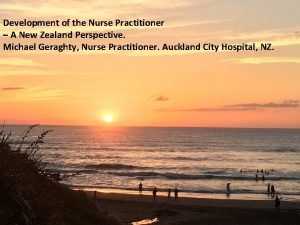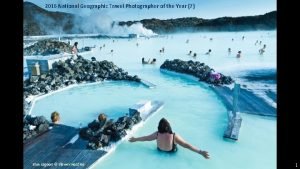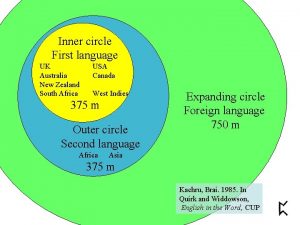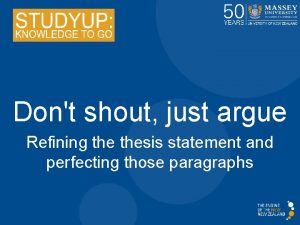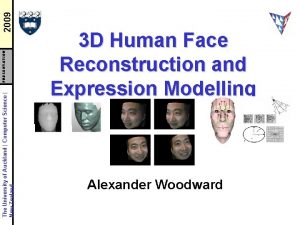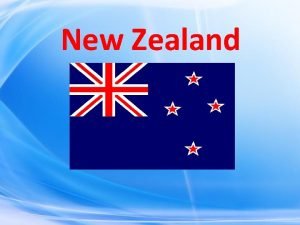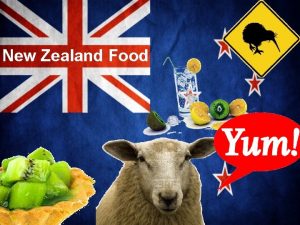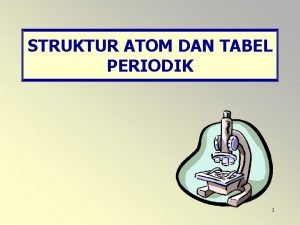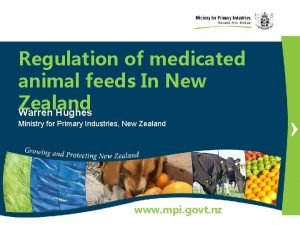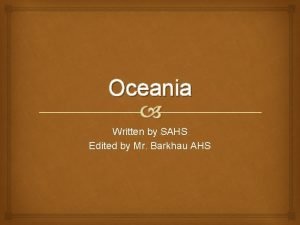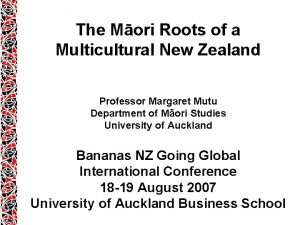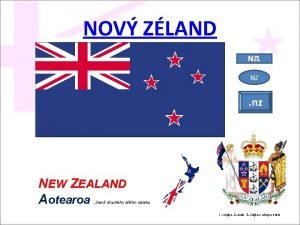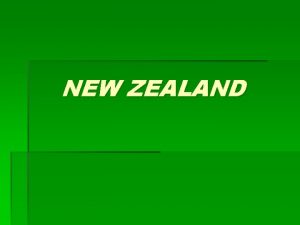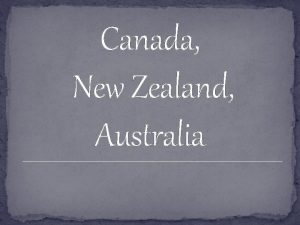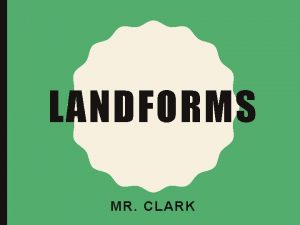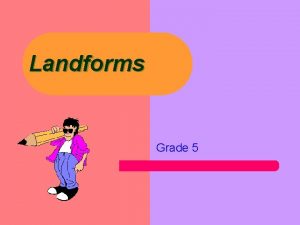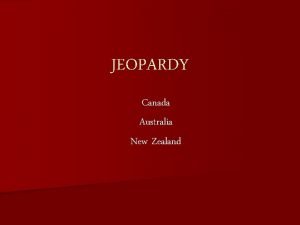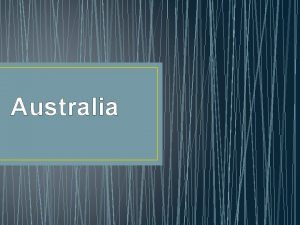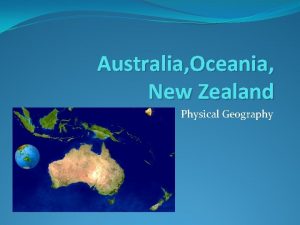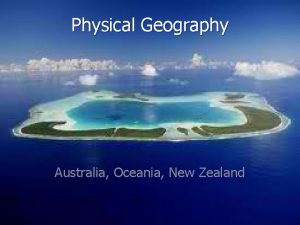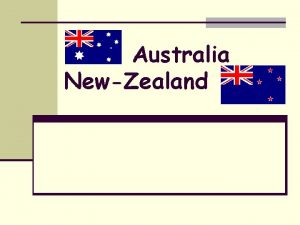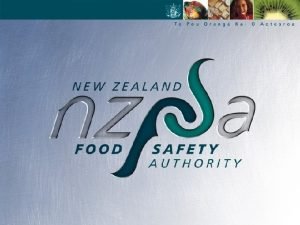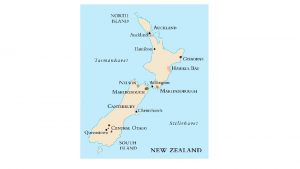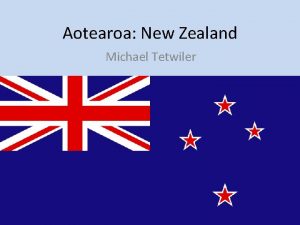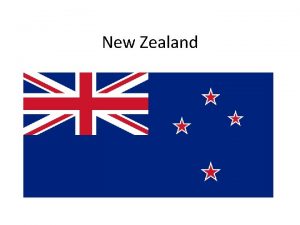Australia and New Zealand Landforms Australia is the
























































- Slides: 56

Australia and New Zealand Landforms

• Australia is the smallest of the continents, and the flattest. Near the eastern coast is a chain of highlands called the Great Dividing Range.

• To the west of this coastal range stretches a vast expanse of plains and plateaus, broken only by low hills and scattered, very low mountain ranges.

• Australia has few rivers that flow all the time. Among those that do flow all year is the Murray River, Australia’s longest river, which flows into the Southern Ocean.

Along Australia’s northeast coast lies the Great Barrier Reef, a 1, 250 -milelong chain of more than 2, 500 reefs and islands.

• https: //www. youtube. com/watch? v=e. Iul 2 O bv. KV 8

New Zealand has two main islands, North Island South Island. Running down the center of South Island is a 300 -mile-long mountain range called the Southern Alps. North Island is much less mountainous than South Island. North Island has fertile farmland forests that support the lumber industry. New Zealand’s swift-flowing rivers have allowed it to build dams that generate electricity. Also, North Island has a volcanic area with underground steam.

New Zealand Mountains Famous for…

Climate

Mountains influence Australia’s climate, with the Great Dividing Range forcing moisturebearing winds to rise and shed their rain before moving inland. One-third of Australia is desert. The desert area lies in an oval in the center of the continent. This region is known as the Outback. It receives less than ten inches of rain a year. Encircling the desert is a band of semiarid climate. This area receives no more than 20 inches of rain a year.

New Zealand the southern part of Australia’s east coast share a marine west coast climate. The seasons have mild temperatures because ocean breezes warm the land in the winter and cool it in the summer. New Zealand receives rainfall year round. However, the amount varies dramatically from one part of the country to the other.

Human Geography

The first people in Oceania probably came from Asia more than 30, 000 years ago. Australia’s indigenous people are called Aborigines. New Zealand’s indigenous people are called the Maori. Most of the population of Australia and New Zealand is of European, mainly British descent. Some of Oceania’s population is also of European descent.

English is the chief language of Australia and New Zealand, although Australian English features special local idioms and words. Christianity, brought by Europeans, is the most widely practiced faith in the region today. Indigenous religions in the South Pacific region focus on the relationship between human beings and nature. Followers of these religions believe that all natural things have spirits and are interrelated. (Dreamtime)

Various people from Asia settled the South Pacific region over 40, 000 years ago. Some may have crossed land bridges that are now submerged; others probably sailed in voyaging canoes and rafts. Those who settled in Australia were known as Aborigines. They followed a nomadic way of life in the hot, dry interior of Australia.

• In Oceania, people settled in kinship groups on island coasts. They built voyaging canoes that allowed them to travel and to trade with other islands. (For use in lagoons, the Pacific Islanders developed outrigger canoes to help balance the canoe. ) Between the A. D. 900 s and 1300 s, the Maori left Polynesia and settled New Zealand.



Beginning in the 1500 s, many Europeans explored the Pacific. British sailor James Cook was the most famous European explorer of the region. Between 1768 and 1779, Cook claimed eastern Australia for Britain, visited Oceania, circled Antarctica, and made accurate maps of the area. In the 1800 s, missionaries, traders, and sailors hunting whales began to arrive. Settlers started plantations to grow coconuts, coffee, pineapples, or sugar.

When Europeans arrived in Australia, there were an estimated 500 Aboriginal groups. In New Zealand they encountered the Maori, who migrated from Polynesia In 1788, Britain founded Sydney, Australia as a penal colony, (Prison Colony). New Zealand was colonized by hunters and whalers from Europe, America, and Australia. Gold was discovered in Australia in 1851 and in New Zealand in 1861. People flocked to these countries to seek gold.

European diseases and weapons greatly reduced the indigenous population. In Australia British immigrants forced Aborigines off their ancestral lands and denied them basic rights. In New Zealand, in 1840, the British and Maori signed the Treaty of Waitangi. This gave Britain control over New Zealand.

In 1901, Australia’s colonies joined into a single, independent nation. New Zealand became self-governing in 1907. Both Australia and New Zealand remained in the British Commonwealth. Many Australians now want to cut ties to the British monarchy and elect a president. The Aborigines and Maori began regaining some of their rights, and immigrants made populations more and more diverse.

Literacy rates are high in Australia and New Zealand, where free education is compulsory to age 15. Both countries provide quality medical care. People who live in remote areas can take advantage of Australia’s Flying Doctor Service and its mobile clinics. Most Pacific Islanders still live in small villages. Generally, a chief leads each village. Usually, each extended family has a house or cluster of houses in the village. Village economies center on farming and fishing. Oceania has few cities, but those that exist have been growing.

Most of Oceania has an economy in which people work not for wages, but at subsistence activities. These are activities in which a family produces only the food, clothing, and shelter they themselves need. Agriculture and Tourism are the regions main economic activities.

• New Zealand earns much of its income by selling butter, cheese, meat, and wool to other countries, and is the world’s largest producer of kiwi fruit. • Australia is the largest exporter of wool in the world. Much of Australia is arid, so only about ten percent of the land is used to grow crops. • Australia earns much of its income from mining. Many mineral deposits lie in the outback. It is expensive to build roads and equip mines in these areas, so Australia has had to rely on foreign investors.

• Australia earns much of its income from mining. • Many mineral deposits lie in the outback. • It is expensive to build roads and equip mines in these areas, so Australia has had to rely on foreign investors.

In 1859, Thomas Austin released 24 rabbits into Australia so he could hunt them. The rabbit population grew faster than anyone could control it. A single pair of rabbits can have up to 184 descendants in 18 months. Plus, rabbits have few natural enemies among Australia’s wildlife. By 1900, Australia had more than a billion rabbits. .

Rabbits wiped out native plants and destroyed crops. They ruined pastures. Some of Australia’s native animals became endangered because of competition for food. . .

• Australians imported foxes to prey on rabbits, but the growing fox population endangered Australian wildlife. In the early 1900 s, the government built a 2, 000 -mile fence to keep rabbits from spreading to the southwest. This fence succeeded only temporarily before rabbits broke through to the new region

• In the 1950 s, the government infected wild rabbits with a disease killing more than 90 percent of the total rabbit population. But rabbits became immune to the disease and their numbers boomed again. Now Australians are using poison, introducing new diseases, erecting fences, and destroying the warrens and burrows where rabbits live.



During the arms race with the Soviet Union, the United States wanted to test nuclear bombs without endangering American citizens. In the 1940 s and 1950 s, the United States conducted 66 tests in the Pacific.

• The U. S. government chose Bikini Atoll for testing because it lay far away from regular shipping and air travel routes. In 1946, the government moved 167 Bikini Islanders to another atoll and conducted two atomic-weapons tests.

• From 1951 to 1958, the U. S. government held several more tests there. Bikini Islanders would like to move back to Bikini Atoll. A cleanup began in 1988. No one knows when Bikini Atoll will be suitable for human life.

• http: //www. dailymail. co. uk/sciencetech/arti cle-3630359/Bikini-Atoll-uninhabitable. Radiation-island-exceeds-safety-standards -nearly-60 -years-nuclear-tests. html


Antarctica was discovered in 1820. Norwegian explorer Roald Amundsen was the first to reach the South Pole in 1911. Antarctica remains unsettled. Twelve countries have scientific research stations there. In 1959, they drafted a treaty preserving the continent for research. Antarctica is a part-time home to between 1, 000 and 10, 000 researchers and scientists, depending on the season. The climate is too cold to support permanent human habitation.

Antarctica is the 5 th largest continent. It’s ice sheet is the largest supply of freshwater on Earth. Antarctica is the Earth’s coldest and driest climate. It is often called a Polar Desert. The only things that can survive there are lichens and mosses that can with stand cold and periods of long darkness. It’s animals are mostly birds and sealife.

Antarctica • Mountains – Transantarctic Mountains • East Antarctic Plateau. Mountains – Transantarctic Mountains – East Antarctic Plateau – Technically a desert



Neutral Antarctica • Many geologists believe there is a wealth of mineral resources below the ice. • In 1991, 26 nations agreed not to mine Antarctica for 50 years.


Oceania is the groupings of islands in the pacific that have populations who share a common cultural background. The large islands in South East Asia are not part of Oceania, since they have not experienced the same amount of isolation and as a result share a closer bond with the rest of Asia. Oceania is divided into three regions: Micronesia, meaning “tiny islands, ” Melanesia, meaning “black islands, ” and Polynesia, meaning “many islands. ”

No one knows how many islands exist in the Pacific Ocean, but some geographers estimate that there are more than 20, 000. As a group, the Pacific Islands are called Oceania. Most Pacific islands fall into one of two categories: high islands created by volcanoes or low islands made of coral reef build up created by a submerged volcanoes. Most low islands are Atolls.


• https: //www. youtube. com/watch? v=p. RD 8 Z wd. PYs. Y – how atolls form

Oceania Climate

Most of Oceania features a tropical rain forest climate. In general, Oceania does not have diverse vegetation. The low islands have poor soil and small amounts of rain, so plants do not grow well. Some high islands have rich, volcanic soil and plentiful rain. These islands have abundant flowers and trees, such as the coconut palm.

During World War II, the Allies and the Japanese fought intense battles in Oceania to gain control of the Pacific. Gradually, the inhabitants of many of the islands moved toward self rule. Since 1962, 12 different nations have gained independence. Many other islands are still ruled by foreigners.

Native customs and contact with the western world have influenced the history and culture of the Pacific Islands. ithe history and culture of the Pacific Islands. Early History • Began to be settled at least 35, 000 years ago • Europeans first encountered the Pacific Islands in the 1500 s. • By the late 1800 s European powers such as Spain, Great Britain, and France controlled most of the Pacific Islands. Modern History • Guam became a U. S. territory in 1898. • Witnessed a lot of fighting during World War II • After World War II the United Nations placed some islands under the control of the United States and other Allies. • Many Pacific Islands gained their independence in the 1900 s. • Several countries still have territories in the Pacific Islands.

Pacific Island Culture • Some culture traits are common throughout the Pacific Islands (example: fishing). • Other culture traits are only found on a specific island or island chain. • People – Nine million people live in the Pacific Islands today. – Most Pacific Islanders are descendants of the region’s original setters. – Large numbers of ethnic Europeans and Asians also call the Pacific Islands home. – Most Pacific Islanders are Christian. • Traditions – Many people continue to practice traditional customs. – People continue to live in ancient villages. – Pacific Islanders practice customary art styles and traditional dances.

Pacific Islanders today are working to improve their economies and protect the environment. • The countries of the Pacific Islands have developing economies. • Key industries include fishing, tourism, and agriculture. • Although some countries do export minerals and timber, their isolation limits trade. • Environmental issues are a concern for many Pacific Islanders. – Nuclear testing grounds from 1940 s to 1990 s – Global warming and rising ocean levels

The region of Australia, Oceania, and Antarctica is home to only 0. 5 percent of the world’s population because much of the land is uninhabitable. Most people live near the coast.

Isolation led to the development of more than 1, 200 languages in Oceania. European languages were brought by colonization. English is the chief language of Australia and New Zealand, although Australian English features special local idioms and words. Indigenous religions in the South Pacific region focus on the relationship between human beings and nature. Followers of these religions believe that all natural things have spirits and are interrelated. Christianity, brought by Europeans, is the most widely practiced faith in the region today.
 Lesson 1 physical geography of australia and new zealand
Lesson 1 physical geography of australia and new zealand Internal medicine society of australia and new zealand
Internal medicine society of australia and new zealand New zealand accent vowels
New zealand accent vowels New zealand values and attitudes
New zealand values and attitudes Australias landforms
Australias landforms Hundertwasser toilet new zealand
Hundertwasser toilet new zealand New zealand official languages english
New zealand official languages english New zealand disability strategy
New zealand disability strategy Wong wai yin
Wong wai yin Colostrum alpha lipid
Colostrum alpha lipid New zealand hotspot
New zealand hotspot New zealand official languages english
New zealand official languages english What is the capital of new zealand? *
What is the capital of new zealand? * Natives of new zealand
Natives of new zealand Urfolk new zealand
Urfolk new zealand Slidetodoc.com
Slidetodoc.com New zealand health strategy 2016
New zealand health strategy 2016 New zealand holiday 2016
New zealand holiday 2016 New zealand vs australian accent
New zealand vs australian accent Nurse practitioner new zealand
Nurse practitioner new zealand Midnight thirst
Midnight thirst Measurement standards laboratory
Measurement standards laboratory Australian english language
Australian english language Thesis statement example
Thesis statement example New zealand
New zealand New zealand population
New zealand population Kumara new zealand food
Kumara new zealand food Jelaskan sistem periodik menurut oktaf new zealand
Jelaskan sistem periodik menurut oktaf new zealand Acvm new zealand
Acvm new zealand What is oceania
What is oceania Mori new zealand
Mori new zealand Nový zéland obyvatelstvo
Nový zéland obyvatelstvo Acn broadband
Acn broadband Acn new zealand
Acn new zealand Hát kết hợp bộ gõ cơ thể
Hát kết hợp bộ gõ cơ thể Bổ thể
Bổ thể Tỉ lệ cơ thể trẻ em
Tỉ lệ cơ thể trẻ em Chó sói
Chó sói Tư thế worm breton
Tư thế worm breton Alleluia hat len nguoi oi
Alleluia hat len nguoi oi Các môn thể thao bắt đầu bằng tiếng đua
Các môn thể thao bắt đầu bằng tiếng đua Thế nào là hệ số cao nhất
Thế nào là hệ số cao nhất Các châu lục và đại dương trên thế giới
Các châu lục và đại dương trên thế giới Công của trọng lực
Công của trọng lực Trời xanh đây là của chúng ta thể thơ
Trời xanh đây là của chúng ta thể thơ Mật thư tọa độ 5x5
Mật thư tọa độ 5x5 Phép trừ bù
Phép trừ bù Phản ứng thế ankan
Phản ứng thế ankan Các châu lục và đại dương trên thế giới
Các châu lục và đại dương trên thế giới Thể thơ truyền thống
Thể thơ truyền thống Quá trình desamine hóa có thể tạo ra
Quá trình desamine hóa có thể tạo ra Một số thể thơ truyền thống
Một số thể thơ truyền thống Cái miệng nó xinh thế chỉ nói điều hay thôi
Cái miệng nó xinh thế chỉ nói điều hay thôi Vẽ hình chiếu vuông góc của vật thể sau
Vẽ hình chiếu vuông góc của vật thể sau Nguyên nhân của sự mỏi cơ sinh 8
Nguyên nhân của sự mỏi cơ sinh 8 đặc điểm cơ thể của người tối cổ
đặc điểm cơ thể của người tối cổ
